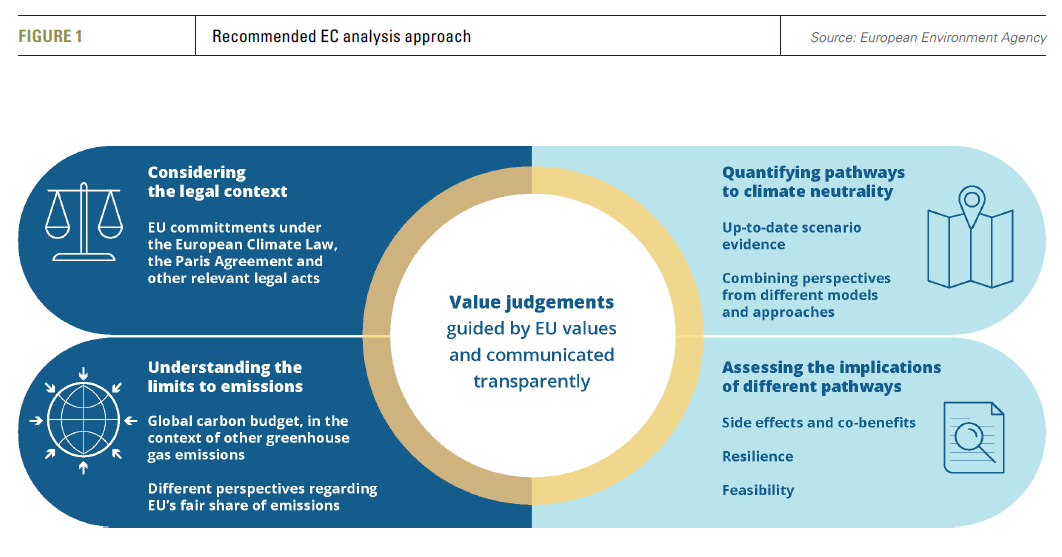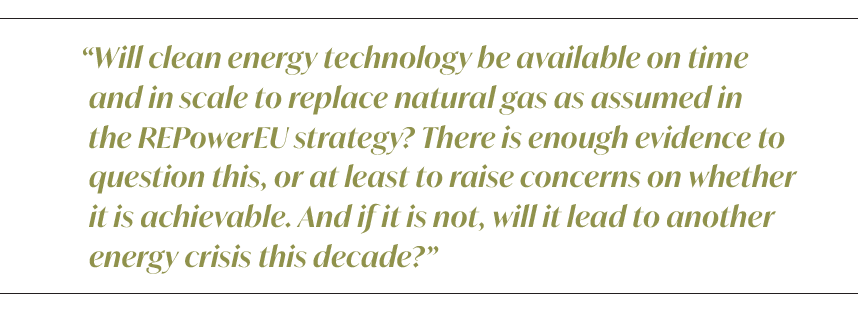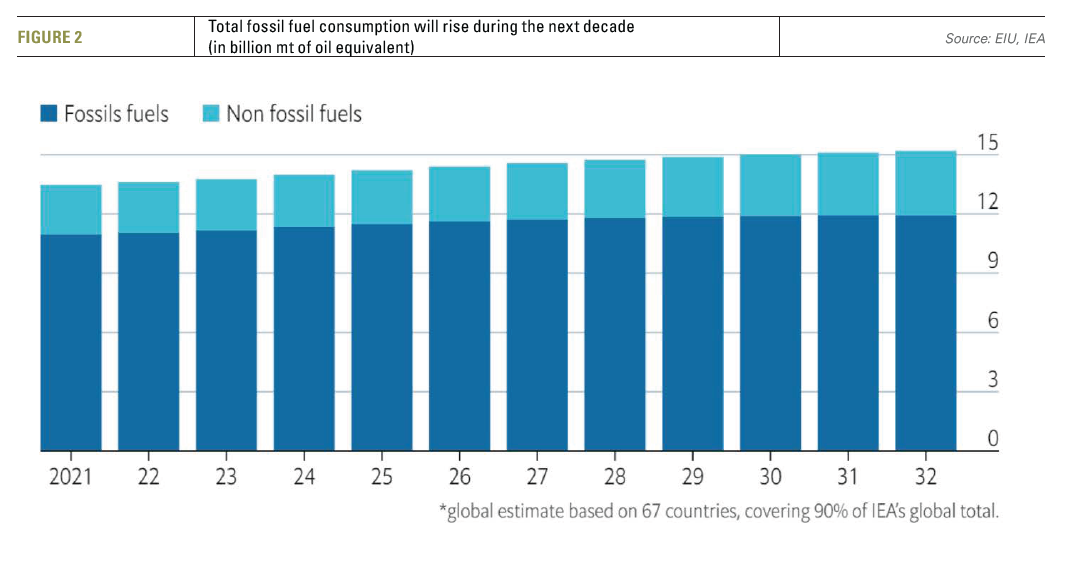The EU needs more accurate modelling tools, data for its climate policies [Gas in Transition]
CONCITO, Denmark’s Green Think-tank, warned in late February that current European Commission (EC) information and data are not always up to date and do not always reflect recent developments in green technologies and recent-past data and trends. Given that such modelling is central to EC’s decision-making process, influencing energy policies and target-setting, with far-reaching implications, this can only be of concern. Modelling assumptions, information and data are central to this process and must be state-of-the-art if they are not to lead to erroneous conclusions.
CONCITO is making the point that the lack of transparency and opaque nature of EC climate modelling data and assumptions make public scrutiny of EC proposals based on such modelling difficult. CONCITO produced examples of imprecise and not up-to-date data used in EC modelling to back-up these arguments.
This basis for such criticism was reinforced earlier in March, when EC agriculture commissioner, Janusz Wojciechowski, acknowledged weaknesses in the data collection process used to put together the EU proposed overhaul of the ‘Industrial Emissions Directive’ (IED). This aims to reduce harmful emissions coming from industrial installations, including emissions from livestock farming. In fact, reports show that the proposal was based on outdated data sets from 2016. Worryingly, the lack of up-to-date data did not stop EC policymakers from going ahead with the proposal.
Another challenge is that most of the existing models were constructed in the last decade, but the climate, social and political realities have changed during the last few years and are still changing. In order to become more relevant to policy-makers, models need to better reflect the recent-past data and trends. Otherwise, they run the risk of producing questionable results and in cases socially unfeasible.
With the EU being a global leader in the transition to a low-carbon energy future, and its determination to accelerate this process and reduce reliance on fossil fuels within this decade, accurate modelling tools and data are essential to ensure the credibility and trust of its climate change proposals.
The debate about more accurate modelling tools and data is particularly important now because European Climate Law requires the EC to propose 2040 climate targets for the EU in the first half of 2024, accompanied by an indicative EU greenhouse gas budget for the period 2030-2050. The work to prepare such proposals has already begun.
The European Scientific Advisory Board on Climate Change recommends that the EC follows an approach that is systematic, transparent and guided by EU values (see figure 1). Clearly accurate modelling is critical in this process. It will have far-reaching implications in determining the EU's climate policies for the next 20 years – hence the debate.
Decision-making process
The EC uses a number of modelling tools and analyses, including impact assessments, to quantify the climate change scenarios used in the development of policy proposals.
The climate policy decision-making process within the EC must be fact-based and transparent. European member states and the public should be able to access, monitor and evaluate the information and models used in developing EU’s climate proposals and policies.
In the current energy and climate crisis, knowledge and evidence-based policymaking are critical. But trust is essential and can be undermined if the basis of such policies becomes questionable.
After the turmoil of the energy crises during the last few years, governments and energy companies are reaching for words like “balance” and “orderly” as they map out the future of energy transition. Trust in EC proposed policies is an essential prerequisite of this process. Especially when the risk of disorderly transition remains.
Based on sound modelling or blind faith?
Modelling assumptions are critical to the development of European climate change policies.
Europe is accelerating transition away from fossil fuels, but is it based on sound modelling and data? Doing so without a safety-net, such as natural gas, could prove to be a folly, with the risk of eventually plunging the EU into another energy crisis.
Natural gas and LNG producers need long-term contracts to underpin development of new projects. But with the EU putting blind faith on the belief that renewables and hydrogen will be there when needed, this is not happening.
The danger is that the EC could fall into the ‘can-opener’ syndrome. ‘Assume you have a can opener’ is a catchphrase used to mock economists and theorists who base their conclusions on unjustified or oversimplified assumptions and data.
In the real world, the energy crisis is forcing governments to reconsider their priorities, with energy security and affordability coming to the top and climate change dropping down the list. They are not prepared to rely on unquestionable faith alone. It will take a long time before energy security ceases to be a top priority. And not before the problems of reliability and long-term intermittency of renewables are satisfactorily resolved. The reality is that global energy transition will take time.
Relying on models based on prescribed outcomes is risky. For example, what happens if the target to achieve 20mn tonnes/yr of green hydrogen by 2030 is not achieved? Will the EU scramble for more natural gas? Where will it get it from if new projects have not by then been developed? And at what price? Will that inevitably lead to another energy crisis? What would be the impact of such folly on energy prices and EU’s competitiveness?
Social participation
EU climate policy has not always prioritised social participation. It is more prescribed – more of a Brussels’ black box than participatory. And if the foundation of such policies - modelling assumptions, information and data – is not up to date, it risks shaking public buy-in.
 Energy transition needs “to be grounded in energy security and trust” - that is, transparent climate policies and adequate and reasonably priced supplies - to ensure public support and avoid dangerous political consequences that can follow, as demonstrated by the dramatic events and public protests in 2022.
Energy transition needs “to be grounded in energy security and trust” - that is, transparent climate policies and adequate and reasonably priced supplies - to ensure public support and avoid dangerous political consequences that can follow, as demonstrated by the dramatic events and public protests in 2022.
As pointed out recently by the Carnegie think-tank, the EU’s notion of a just-transition is more top-down – the social participation element is missing. Only by ensuring social engagement and support can the EU sustain its ambitious climate transition drive.
Carnegie warned that social awareness and green agendas cannot be successfully advanced in isolation from each other, “they need to be conceived and implemented as two sides of the same just-transition coin.” If EU citizens feel they have more input, and say, into shaping the climate agenda, they are more likely to support energy transition measures over the long-term.
Impact on the European gas market
The European gas market appears to have entered into a new phase: a “new energy normal.” Gas prices are down from their peak, but Europe faces a long-term loss of competitiveness. Surely this cannot be acceptable as the new energy normal. The EU needs a longer-term solution that will bring energy prices down.
The EU’s position, embodied in its REPowerEU strategy, is to reduce gas consumption in Europe by 30% by 2030, and carry on reducing this further on the way to achieving net-zero emissions by 2050. It already achieved a 13% reduction in 2022, in a large part because of the mild winter. This discourages European utilities from entering into long-term gas purchase contracts that are needed to encourage development of new gas fields that require 20+ years of exports.
But is this position tenable? Will clean energy technology be available on time and in scale to replace natural gas as assumed in the REPowerEU strategy? There is enough evidence to question this, or at least to raise concerns on whether it is achievable. And if it is not, will it lead to another energy crisis this decade?
Chevron CEO, Mike Wirth, warned at CERAWeek: “We have to be very careful about turning system A off prematurely and depending on a system that doesn't yet exist and hasn't been proven.” Wise words. Transition needs to progress hand-in-hand with energy security and not be based on assumptions that when needed greeb energy technology will be there.
Luck rather than strategy?
The EU was quite lucky this winter. EU scientists say it was the second-warmest winter on record. Quite fortuitous in an energy crisis, limiting natural gas and energy consumption. This prompted the EC energy commissioner to call it “battle won.” But it may not be the case during the next winter.
Climate change is affecting climatic conditions, causing what is known as ‘lazy’ winds, not accounted for in outdated historical data. When this happens, and renewables underperform – expected to be a frequent phenomenon in Europe - the fallback is natural gas. How is this accounted for in EC’s climate modelling?
Widespread drought, happening now, may still produce problems during the summer with reduced hydropower and nuclear due to lack of cooling water. In September hydropower was down 26% in the EU and 42% in Portugal. This is expected be a recurring phenomenon, putting pressure on natural gas to cover the power deficit. Again, how is this accounted for in EC’s climate modelling?
Renewables are subject to long-term intermittency. The more renewables you have, the more you have to rely on and pay for baseload back-ups. Intermittent supply from a variety of power generation adds to the challenge of balancing the grid. Back-up is required, and keeping it available comes at a cost. How is long-term intermittency accounted for in EC’s climate modelling?
There are no reliable and dependable solutions for long-term intermittency. The road to cleaner energy will be long and arduous, with natural gas needed for a long time to come. Eventually Europe must recognize this and accept that new long-term gas contracts – greater than 15 years - required to justify the necessary investment in oil and gas E&P and infrastructure, will be essential. Europe needs a more secure gas supply strategy than just buying on the spot market with little control on prices and quantities.
Concerns
Energy transition to where? The lack of agreement on the right way forward – seen also at COP27 - reflects the fact that there are no clear answers yet how the world will get the energy it needs reliably, securely and affordably. That is why COP27 shifted the emphasis to climate change adaptation, not just mitigation, and set up a roadmap to lay out adaptation actions to meet by 2030.
We all agree we need to act now to keep the Paris Agreement alive. But how can this be achieved if reliable clean energy energy technologies are not yet available to replace fossil fuels. And it is not just in power generation, it must include all other sectors. The global energy mix remains heavily reliant on fossil fuels. These accounted for about 81% of total energy consumption in 2022, and are expected to drop only marginally, to 78%, over the next ten years. If anything, the expectation is that in absolute terms the consumption of fossil fuels will rise over the next ten-years as more energy will be required to fuel the growing global economy (see figure 2).
This is what prompted Chevron’s CEO, Mike Wirth, to stress the need to avoid a “chaotic energy transition” at CERAWeek early March. The world needs to “focus on supply chain, economies, and affordability, keeping up with changes in the energy mix, in order to prevent a disorderly or chaotic energy transition.”
Climate modelling based on optimistic assumptions that clean energy technology will become available when needed to replace fossil fuels is simply just that – optimistic. In a report last year, the International Energy Agency (IEA) concluded that “of the 55 components tracked, 2 are fully on-track with the ‘net-zero by 2050’ scenario trajectory,” prompting the IEA to warn that “the clean energy economy is gaining ground, but greater efforts are needed now to get on track for net-zero by 2050.” There is a long way to go.
As demonstrated at COP27, governments and companies will not commit to phasing-out fossil fuels until it is demonstrated that future energy supplies are secure, reliable, dependable and affordable.
And while energy transition is progressing, which undoubtedly it will, fossil fuels – preferably not coal – must be available in addition to increasing quantities of low-carbon energy.
There is already an escalating push-back with EU member states resisting laws that threaten industries, concerned at the impact of EC’s increasingly more ambitious climate agenda. This includes Italy’s prime minister, Giorgia Meloni, who warned in March that the EU’s growing environmental push, if poorly formulated, “risks damaging our economic fabric.” Realisation that modelling, data and assumptions, that underpin these laws, may not be up to date would exacerbate such resistance.



